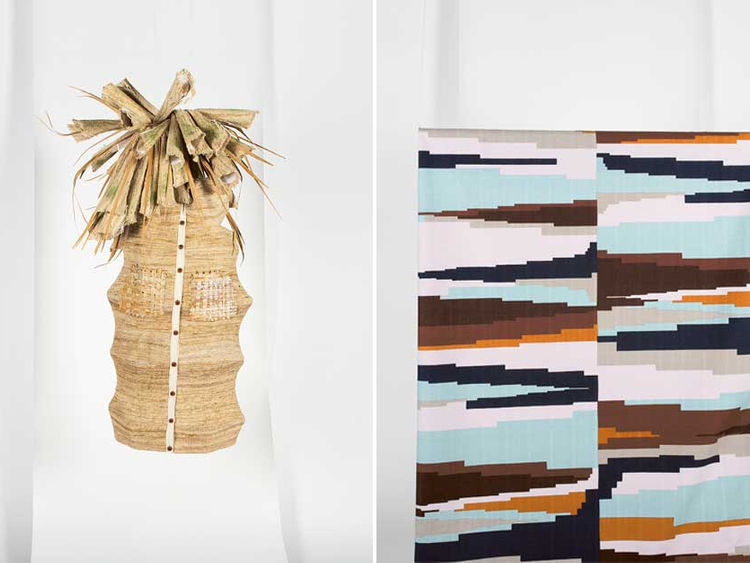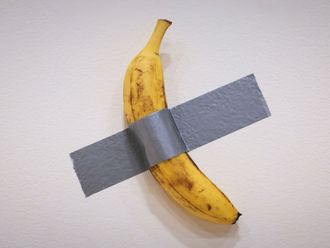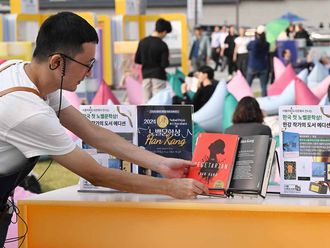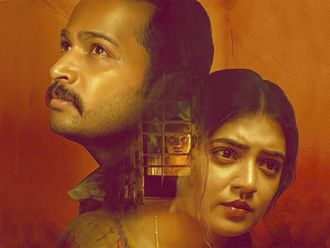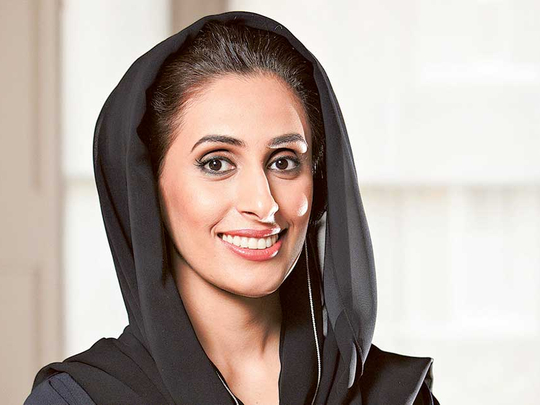
The medium of contemporary fashion provides the designers featured in “De.Fash.Struction” ways of exploring and documenting the UAE’s rich cultural heritage and modern references. They have successfully employed the techniques of deconstruction in their newly commissioned projects for this exhibition.
The artist/designers take cultural and local narratives as source material and the garments call attention to the mechanics of their production, which in turn becomes a process of analytic creation unveiling multiple aspects and vantage points that the designers chose to respond to.
The work shows heritage practices that have been rooted in the UAE years before the country’s formation till today. The designers point to past and present economic practices, ornamental methods and domestic customs through their work. For many of the exhibits, the artists have sought the collaboration of traditional and an older generation of crafts people, reflecting the rich vein of continuity with the country’s past.
The exhibition also highlights the designers’ research on the modernisation of the urban fabric of the UAE, as well as their views of contemporary architecture and the metropolis surrounding them.
Nature is also present in the exhibition in the form of designed fashion objects that pose the themes of nature in the UAE, whether it is the presence of the palm tree or the sea, both of which serve as rich sources of sustenance in relation to man.
For Ahmad Al Anzi from Abu Dhabi, “The Bisht” is his first work as an artist. Having graduated in Environmental Science and Marine Biology from Auckland, Al Anzi says he has always been interested in arts, since his mother was an artist. But then, without any clear career guidance available at that time, he had to keep his interests aside and pursue science.
The Bisht is usually worn over the “Kandoura” during formal occasions. He has subtly used upcycled and recycled items and local material such as palm leaves with light thin gold application to create “The Bisht”, which does not follow any body form but is a showstopper in many subtle ways.
The artist pays homage to his Emirati roots by enlisting his neighbour, a skilled wicker weaver, and jointly working with his artist mother on the braiding, emphasising the larger role of family in the UAE.
In his work, he has combined the contemporary and Bedouin lifestyle elements to convey a message to his countrymen that “you could be proud of your heritage and stand out, without it being in conflict with the rest of the world. There is no scope for an identity crisis”.
Al Anzi considers it “a great honour to take part in this show along with senior artists whom I consider as my mentors”.
Architectural heritage
Alia Dawood, a British architect based in Dubai since 2012, takes inspiration from the architectural heritage of Dubai from the 1970s. The iconic buildings of that time, such as the World Trade Centre and the Toyota building on Shaikh Zayed Road, are an enduring reference point in the Emirate’s urbanisation process.
She has attempted in “Dubai World Trade Centre Deconstructed” to deconstruct the architectural elements of the building, using fabric and thread. Dawood recalls how she picked one element — the window — and decided to repeat it to look like a classical Islamic architectural pattern with the aid of computerised sewing.
Dawood, who has done Masters in Art after receiving a degree in architecture, feels that after the positive reactions from viewers to her work, she would like to develop the idea further and work on a bigger format/medium.
For Dawood, the visually engaging pattern she has created is a homage to the Islamic and Arabic heritage and culture.
Colonial connections
Faissal El Malak came across the Maria Theresa Thaler coin while researching traditional crafts and objects in the UAE. It was named after the Austrian Empress — Maria Theresa — and was popular all over the Arab world and in the Gulf from the end of the 18th century until recently. It was first minted in 1751 and kept the same date of 1780 after the empress’s death.
El Malak says the coin is so popular in the Middle East that it is still in production. Used for trade, but also incorporated in jewellery and clothes as a marker of wealth, it played an important part in the region’s daily life and rites of passage such as dowry.
“I have used it as a motif, like the polka dot which was so popular in the Emirates in the 1950s and is even now available in local souks, usually paired with white, red or green background material. I have used two traditional elements into this piece and tried to create something modern — a new interpretation,” says the young Paris-educated fashion designer, a Palestinian who grew up in Canada and Qatar.
Using a popular colour combination of red and white, he added an illustration of the Maria Theresa Thaler in the middle of the dots. In reference to the opulence of baroque dress, it was produced using a red silk taffeta and an appliqué of white silk with black thread embroidery for the Maria Theresa dots. The motif gradually unfolds to reach a final chaos with the polka dots shifting from their original positions to reveal cut-out work where their base would have been.
Now based in Dubai, El Malak feels at home here. “Emiratis are very welcoming and kind,” he says.
At the time of this interview, he was busy working on a new collection for “Who is On Next? Dubai”, a scouting project launched by “Vogue Italia” and Emaar. He is among 25 designers from across the Middle East, Asia and Africa to have been selected as finalists for the event held on October 29-30 at The Dubai Mall.
Tree of life
Tijana Mladenovic, a Serbian, has been living in her home country and Dubai, where her parents are based, for the past 15 years. She displays her knowledge of Emirati history, culture and environment in her work “Tree of Life”, made of tussar and raw silk and dried palm leaves.
Mladenovic, who has studied fashion and costume design at ESMOD, Paris, and graduated two years ago, is part of the fashion design portal Not Just the Label and was approached by the curator when she happened to be in Dubai.
The “Tree of Life” is conceived as a palm tree and the designer uses the theme to recreate the story of the formation of the UAE and its spectacular success and progress.
The trunk represents the different Emirates before the Union, while the upper part is the fruit of the Union, which is productive and diverse as the date palm.
She has been able to merge the palm leaves into the design, and she explains that the fabric has been exposed to the sun to mimic the climatic and environmental effects of the palm tree. By randomly punching in and pulling out some strands, the designer deconstructs the material that goes into the piece.
Inspiration from sadou
In her work titled “Dejavu”, Katya Kovtunovich seeks inspiration from the hand-made sadou, a material widely used in the UAE for upholstery. Deconstructing the traditional approaches to fabric, she has used sadou made by an Emirati woman artisan, whose prayers while making the fabric have infused it with a special resonance. The dress is a transformation of furniture material into evening wear “fit for the red carpet”. The rough and refined are yoked together. The feminine gown and the masculinity of the tuxedo are combined to create a new reality.
Kovtunovich, from Russia, studied languages and began her career as a fashion journalist in London. After coming to Dubai three years ago, she transformed herself into a fashion designer, earning praise for her collections.
For Kovtunovich, the sadou becomes a reflection of the UAE — a country that embraces diversity of contrasts in cultures, religions, histories and pasts, all coexisting in an incredible harmony.
Kovtunovich was also invited by Expo 2020 — the successor of Expo Milano 2015 — to showcase her work as part of the celebrations dedicated to the UAE in Milan on October 20.
“I break boundaries of the conventional use of sadou, rethinking its traditional role and giving it the central stage and limelight as a fully functional high fashion fabric. I love seeing new potential in people, places and fabrics,” Kovtunovich comments on her collection to be showcased in Milan.
Ornamental culture
In “Yadoo”, Saeed Khalifa explores hairstyles in the past with the aim to deconstruct traditional methods and shed light on the ornamental culture of the UAE. He attempts to highlight the traditions of hairstyling in the past by photographing the deconstructed traditional hairstyles in a contemporary form of a high-fashion editorial.
He aims to shed light on the beauties and particularities of the fashion culture of the UAE that go beyond what is commonly recognised nowadays. The project features Khalifa’s grandmother as the subject and model of his photographs.
In “Tent-Remental”, Tahir Sultan draws on the Arab Bedouin culture, specifically looking at the “tent”. He uses woven wicker and ropes to create a 3D head piece, and leather to create patterns in a jacket piece that echoes a saddle bag used mainly to carry both milk and water. He also uses metal pegs in reference to the tent. The final outcome is an outfit made of six elements rooted in the heritage of the UAE and the region.
A deconstructed dress of brown and white stripes is inspired by the traditional tent. He also uses ropes that are usually used to balance and suspend the tent in a dramatic display.
The dress with pieces that are woven out of stiff wicker by an NGO in India sheds light on the historical and cultural ties between the two countries. The two pieces created jobs for 15 women there and is what he believes fashion should aspire to do. He also notes that the designs on the dress are inspired by traditional henna patterns.
Fashion films
Cinema Akil, an independent cinema platform that brings quality films from across the world to the audiences in Dubai is also present at the show in 1971. The short films that run throughout the exhibition seek to project a story that ties together aspects represented at the exhibition.
1971, the design hotspot
1971, the UAE’s newest experimental design hotspot, can be found on Sharjah’s iconic Flag Island. Far more than a gallery, the innovative art space aspires to become a regional and international design hub in the UAE that works closely with regional designers, architects, schools and universities to present a contemporary and cutting-edge mix of curated exhibitions and public programmes.
Interview:
De.Fash.Struction was more like a journey: Khulood Thani
Born and raised in Dubai, Khulood Thani is the first Emirati to hold a degree in fashion management and marketing from ESMOD, Paris, the oldest sartorial institute in France. She also studied at the London College of Fashion and Central Saint Martins, and received a masters degree in strategic marketing from the University of Wollongong and a BA in marketing communication from Zayed University in Dubai.
Combining the meticulous skill of a designer with the sharp mind of an entrepreneur, Thani launched BINT THANI in 2012. The brand quickly became known in the region for its distinctive silk turbans, and most recently for everyday luxury designs that are grounded in Dubai yet have global relevance. Her strong interest in fashion history and major art and design movements heavily influence the label’s collections.
She works from her experimental studio set in Dubai’s industrial area of Al Quoz, where she also writes about fashion trends for a number of leading regional publications.
In an exclusive interview with Weekend Review, Thani, who has extensively exhibited her work in the UAE and other art and fashion capitals of the world, speaks about her present show at 1971 — Design Space at The Flag Island, Sharjah. Excerpts:
How did the idea for this path-breaking show emerge and how long did you take to bring this together?
Putting the idea of the exhibition together was more of a creative collaboration between myself and 1971. The work involved in bringing the overall concept, idea and exhibition segments together took almost one year.
What were the artistic aims you sought to achieve through this show?
The main aim was documenting the UAE in more of a contemporary fashion approach, employing “deconstruction” as a technique of the contemporary fashion.
There are few areas that we focused for “De.Fash.Struction”, which are: handicrafts, heritage in general and the UAE’s current references, such as the modern architecture.
How did you go about selecting such an eclectic mix of nationalities and artists?
We first defined the areas of the exhibition — fashion, textile, jewellery, accessories and photography. Based on these areas we started approaching certain designers and photographers.
The selection was not purely for fashion designers, we approached mainly creative people from different areas of design, such as product designers, architects and experimental artists, because we also wanted a fresher eye for fashion.
Are you satisfied with the outcomes? What are the reactions from art lovers and critics?
Being the first-ever UAE fashion exhibition focusing on contemporary fashion, we have got lots of positive feedback about the content. It is due to the fact that we worked closely with the designers/artists in briefing them, giving feedback on the spot if we had any and they were very responsive and accommodating. “De.Fash.Struction” was more like a journey for us and them.
What are your future curatorial projects? Will you be having further editions of “De.Fashion.Struction”?
This has been the only curatorial project for this year, and I hope to see this project growing.
[N.P. Krishna Kumar is a freelance writer based in Dubai.
“DE.FASH.STRUCTION: Telling stories through fashion”, curated by Khulood Thani, runs until December 26 at 1971, The Flag Island, Sharjah.]


